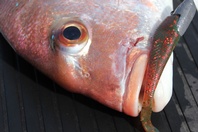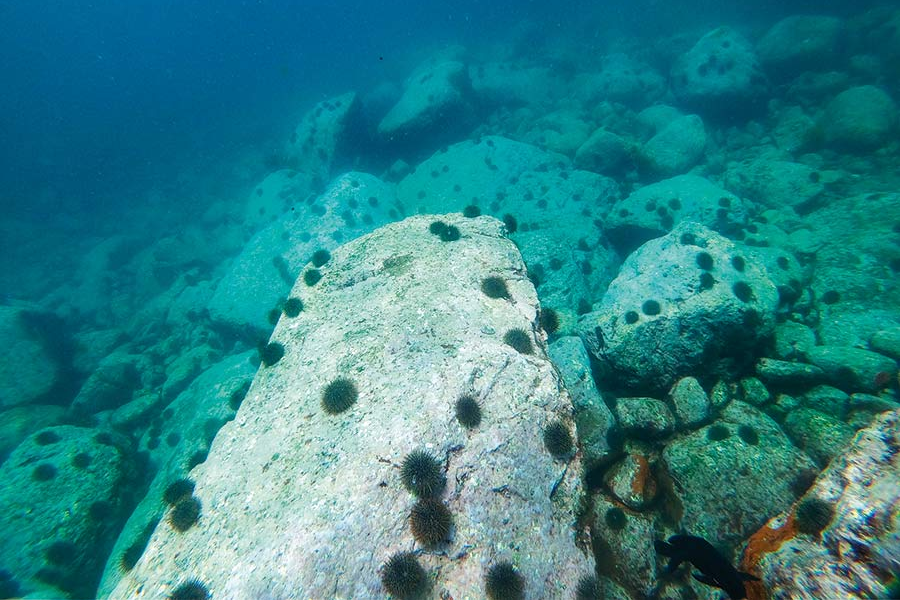Snapper and Kina Barrens
University of Auckland Masters student Jessica Marinovich is investigating what snapper eat. She is specifically trying to figure out how important kina (sea urchins) are to snapper diet. Kina, being a voracious herbivore (seaweed eater), have the ability to graze rocky reefs into a barren habitat devoid of seaweeds. So, by understanding how much and what sizes of kina are eaten by snapper, Jessica can assess the importance of snapper in controlling kina barrens on rocky reefs. To do this, she needs your help sourcing bagged and frozen gut samples from snapper caught or speared over shallow rocky reefs. We are mostly interested in the Leigh, Tawharanui, Little Barrier and Kawau areas, but will take gut samples from reefs throughout the Hauraki Gulf.
If you have ever walked through a stone arch and looked up, you will have noticed a larger stone in the centre of the arch known as the keystone. Without this central stone the arch would fall down; it locks the whole thing together. The term keystone has also been applied to species that are very important to maintaining the composition of the ecosystem they live in. This concept was first coined by researchers on the west coast of the United States in the 1960s who had removed sea stars from experimental plots in the intertidal zone along the coast. Over the next few months, they saw the number of other species in the intertidal zone drop until the entire intertidal zone was dominated by one species of mussel. The sea star, by preying on other animals, was reducing competition for space and as a result keeping balance in the ecosystem.
Another example of a keystone species comes from Alaska, where the sea otter was hunted to near extinction for the fur trade. Sea otters were eventually protected, and by the 1970s locations where their populations had recovered were also noticed to have much more kelp growing on rocky reefs. This was because the otters were feeding on sea urchins, which had been left to graze down the kelp when unchecked by predators – this chain of interactions is known as a “trophic cascade”.

An underwater glimpse of a kelp forest at the Mokes. Photo : Paul Caige.
You might be asking, what has this got to do with the snapper that I catch? Well, snapper (along with crayfish) have been suggested to play a keystone role in kelp forests by controlling kina numbers. In the 1990s a similar pattern was recorded in north-eastern New Zealand. Many wave-exposed rocky reefs in north-eastern New Zealand exhibited an urchin or kina barren habitat, devoid of seaweed, between ~3 and 10 m depth. If you are a spearfisher you will have undoubtedly noticed it as you dive down. There is usually a zone of brown algae around the low tide mark, then the reef is bare for the next 8 metres or so (that’s the kina barren), before getting down to a kelp forest deeper on the reef. It hasn’t always been this way though, as kina barrens were only observed to replace kelp forests from about the 1950s. By the 1990s, however, crayfish and snapper populations in New Zealand’s first marine reserve near Leigh (known as the Goat Island Marine Reserve) had recovered to be much more abundant than on adjacent pieces of rocky coast. At this time it was also noticed that the number of kina was much lower than outside of the reserve, and the abundance of kelp much higher. Overall primary productivity (the ability of plants on these reefs to capture the suns energy and introduce that energy to fuel the marine food web) was estimated to be more than 50% higher in the reserve than on adjacent fished pieces of coastline. The abundant crayfish and snapper inside the reserve were shown to be feeding on kina and the most likely reason for the long-term decline of kina barrens in the reserve. Consequently, the reduced populations of crayfish and snapper outside of reserves have been suggested to be responsible for the prevalence of kina barren habitat on many north-eastern New Zealand reefs.
There are undoubtedly more pieces in this puzzle though. For example, kina don’t like sediment and that may explain why kelp forests are able to prevail at greater depths. Sediment tends to settle at these depths and may help keep the kina away. You may have also noticed that rocky reefs in the inner Hauraki Gulf (where the water is more murky) don’t have kina barrens, and instead have kelp and seaweed forests. This is thought to be due to the higher sediment in these locations keeping the kina at bay. Other factors may also influence kina numbers. For example, blooms of toxic microalgae over summer can lead to declines in kina populations in localised areas leading to temporary recovery of kelp forests.
At this point I am sure many readers will be recalling the snapper they have caught over rocky reefs with stomachs full of kina – and this is where we need your help. Snapper have long been thought to be one of the main predators of kina, but there is little information on how many and what size of kina they eat. That is what we are addressing now. We want to know how important kina are to snapper diet and if that is the same for small or large snapper. To do this we need snapper gut samples, including the length and approximate location of the snapper that was caught. With these samples, we can figure out the size of the kina that were eaten. You may have noticed the mouth parts of a kina contain “teeth”. So if these teeth are in the snapper guts, we can measure them and estimate the size of the kina when it was whole. We are mainly interested in getting gut samples from snapper caught or speared over shallow rocky reefs around the Leigh and Tawharanui Marine Reserves, but will take samples from throughout the Hauraki Gulf. Once all of these gut samples have been processed in the lab, this information will be combined with the size compositions of kina and snapper inside and outside of these two reserves (both of these bits of information are already known). Together this will help us to better understand the role of snapper in controlling kina populations.

Kina can replace kelp forests on shallow reefs if their numbers aren't kept in check. Photo: Nick Shears
If you are able to help, please get in touch with Jessica by email at [email protected]. She can drop off a pack of zip lock bags and labels for you to store snapper guts in your freezer prior to pick up.

April 2022 - Darren Parsons
New Zealand Fishing News Magazine.
Copyright: NZ Fishing Media Ltd.
Re-publishing elsewhere is prohibited
Recent Posts Visit Forum
SMUDGE
in The Briny Bar27 minutes ago
JustAnotherSpea
Hey Smudge, have a cracker weekend and congratulations on another lap around the sun!...
Small power cat
in The Boat Shed3 hours ago
FishyHooker
Hi Shambles - Did you ever get to grips with the minicat?. I'm currently looking at one and think it fits my purpose almost perfectly, but...

POPPING VANUATU
in Popper and Topwater Fishing16 hours ago
FarmerBrowne
Halco Rooster Poppers and River to Sea Dumbell poppers are also commonly used and effective where I mostly fish now days (Aitutaki). I personally find the...

Spammers Beware!
in Forum comments and feedback18 hours ago
Pcj
How does it keep getting through??Edit Grunta: All gone Paul - I've removed the links as they don't go anywhere but thanks for the heads-upThe reality...

Auckland Yakkers
in Yak Yak Yak18 hours ago
Hard Yakker
The birds were at Campbells today, yes all of the birds, I've never seen so many birds. It was a hot session, and surely a bad...
Popular Articles

Softbait Fishing - Part 1 - gear selection
John Eichlesheim writes an article about selecting the right equipment for softbait fishing... Read More >

Softbait fishing Pt 2 - tips and tricks
Techniques, tips and tricks of softbait fishing – getting the most from your soft baits.... Read More >

Surfcasting - setting yourself up
Gary Kemsley helps sort out the necessary gear for intending surf fishers.... Read More >

Squid - How to catch them
Squid fishing is a rapidly growing aspect of fishing - Paul Senior shares some hints and tips to get started.... Read More >
Fishing Reports Visit Reports
Bream Bay Fishing Report - 18/04/24
Change in seasons, change in tactics Not a lot to report in the ‘big fish’... Read More >
Canterbury Fishing Report - 04/04/24
Fish galore! Coming off the back of Easter Weekend and with some very nice weather... Read More >
Raglan Fishing Report - 04/04/24
Excellent snapper action There is some excellent autumn snapper fishing straight out and up the... Read More >
Bream Bay Fishing Report - 04/04/24
Whangarei Harbour fishing well Like the weather, the fishing has been patchy throughout Bream Bay... Read More >

Comments